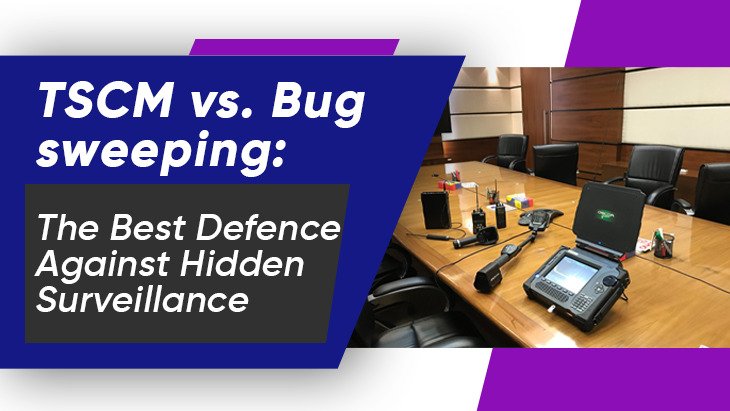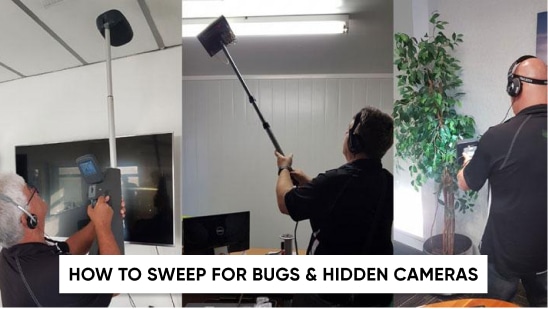Treading of our privacy rights have become difficult in the recent past, and thus, organizations and individuals need to come up with the best strategies towards protecting their secrets. Two commonly discussed strategies in the realm of counter-surveillance are Technical Surveillance Counter-Measures (TSCM) and bug sweeping services. Though they share a common goal of detecting and neutralizing hidden surveillance devices, their approaches and effectiveness can vary significantly. This article delves into the nuances of TSCM vs. bug sweeping, helping you understand their strengths and applications in the fight against unauthorized eavesdropping.
The Growing Threat of Hidden Surveillance
The proliferation of surveillance technology has made it easier than ever for malicious actors to spy on others. Advances in miniaturization and wireless technology have resulted in covert devices capable of capturing audio, video, and data. These can be hidden in everyday objects, making detection difficult without specialized equipment or knowledge.
Corporations, government agencies, and even private individuals face risks ranging from industrial espionage to personal privacy invasions. The need for effective counter-surveillance methods is thus critical. Two such methods are TSCM and bug sweeping.
What is Bug Sweeping?
Definition and Techniques
Bug sweeping refers to the process of detecting surveillance devices (often called “bugs”) that are hidden within a specific area. This process typically involves the use of electronic equipment designed to detect the presence of transmitters, microphones, and cameras that could be used for unauthorized surveillance.
Key Techniques in Bug Sweeping:
- RF Detection: Radio Frequency (RF) detectors scan for signals emitted by wireless surveillance devices. These detectors can identify frequencies used by common eavesdropping devices.
- Non-Linear Junction Detection: This technique identifies electronic circuits in devices, even if they are not currently transmitting signals, by detecting the semiconductor junctions that are characteristic of electronic components.
- Thermal Imaging: Thermal cameras can detect the heat emitted by hidden electronic devices, particularly useful for identifying devices that might be inactive or dormant.
- Physical Inspection: A thorough physical search of the area is conducted to spot unusual objects or modifications that could indicate the presence of hidden devices.
Applications and Limitations
Bug sweeping is often used for routine inspections and in scenarios where the primary concern is the detection of known surveillance technologies. It is a relatively straightforward process that can be carried out by trained personnel using off-the-shelf equipment.
However, bug sweeping has limitations:
- Scope: It typically focuses on the detection of active devices and might miss passive or dormant ones.
- Expertise: It requires a certain level of skill to interpret the results accurately and to avoid false positives.
- Adaptability: Advanced or custom-built surveillance devices may evade detection by conventional bug sweeping methods.
What is Technical Surveillance Counter-Measures (TSCM)?
Definition and Techniques
Technical Surveillance Counter-Measures (TSCM) encompasses a broader and more sophisticated set of practices designed to detect and neutralize electronic surveillance threats. TSCM is more comprehensive than bug sweeping and involves a multi-faceted approach to counter-surveillance.
Key Techniques in TSCM:
- Electromagnetic Field Detection: Identifying variations in electromagnetic fields that may indicate the presence of hidden electronic devices.
- Signal Analysis: Analyzing electronic signals in the environment to identify anomalous transmissions that could suggest unauthorized devices.
- Spectrum Analysis: Detailed examination of the radio spectrum to detect unconventional or low-power transmissions.
- Infrared and Ultraviolet Analysis: Utilizing infrared and ultraviolet light to detect the presence of surveillance devices that may not be visible in the normal spectrum.
- Conducting Security Surveys: Comprehensive assessments of the physical and electronic security measures in place, identifying vulnerabilities that could be exploited for surveillance.
- Countermeasure Development: Implementing technical and procedural measures to mitigate identified risks, such as using encryption, securing communication channels, and educating personnel on security protocols.
Applications and Limitations
TSCM is typically used in high-stakes environments where the risk of sophisticated surveillance is high, such as in government facilities, corporate boardrooms, or high-profile residences. It requires a high degree of expertise and often involves the use of advanced equipment and methodologies.
However, TSCM also has limitations:
- Cost: TSCM is resource-intensive, often requiring significant investment in equipment and skilled personnel.
- Complexity: The comprehensive nature of TSCM can make it complex to implement and maintain.
- False Sense of Security: Over-reliance on TSCM without proper integration into a broader security strategy can create vulnerabilities if other aspects of security are neglected.
Comparing TSCM vs. Bug Sweeping
To determine the best defense against hidden surveillance, it’s crucial to compare TSCM and bug sweeping across several dimensions:
1. Scope of Detection
- Bug Sweeping: Primarily focuses on detecting active surveillance devices through direct means such as RF detection and physical searches. It is well-suited for routine checks and environments with lower security demands.
- TSCM: Offers a broader approach, including the detection of passive, dormant, and sophisticated surveillance technologies. It is ideal for high-risk environments where comprehensive counter-surveillance is necessary.
2. Level of Expertise Required
- Bug Sweeping: Can be performed by trained personnel using commercially available equipment. The interpretation of results, however, requires a certain level of expertise to avoid false positives or negatives.
- TSCM: Requires highly skilled professionals who are trained in the use of advanced detection equipment and methodologies. The complexity of TSCM demands a deeper understanding of surveillance technologies and countermeasures.
3. Equipment and Techniques
- Bug Sweeping: Utilizes more straightforward, generally available tools such as RF detectors and thermal imagers. These tools are effective against standard surveillance devices but may struggle against more sophisticated threats.
- TSCM: Employs a range of specialized equipment for in-depth analysis, including spectrum analyzers and electromagnetic field detectors. TSCM is more adaptable to emerging and custom-built surveillance technologies.
4. Cost and Resource Allocation
- Bug Sweeping: Is generally more cost-effective and can be performed with a moderate investment in equipment and training. It is a practical solution for organizations with budget constraints.
- TSCM: Involves higher costs due to the need for advanced equipment and specialized personnel. It represents a significant investment in security and is usually justified in high-risk or high-value contexts.
5. Frequency of Use
- Bug Sweeping: Can be performed regularly as part of routine security checks. It is suitable for environments where ongoing monitoring is necessary but the risk level is moderate.
- TSCM: Is typically conducted periodically or in response to specific threats or incidents. It is used strategically rather than routinely due to its resource-intensive nature.
Choosing the Right Approach for TSCM vs. Bug Sweeping
The decision between TSCM and bug sweeping depends largely on the specific needs and risk profile of the organization or individual:
When to Choose Bug Sweeping
- Routine Inspections: Ideal for regular, scheduled checks in environments where surveillance risks are perceived to be lower.
- Budget Constraints: Suitable for organizations with limited resources that still require a baseline level of surveillance detection.
- Standard Threats: Effective against common surveillance devices that are readily detectable with conventional methods.
When to Choose TSCM
- High-Risk Environments: Necessary for situations where the stakes are high and the potential for sophisticated surveillance is significant.
- Complex Threats: Best suited for detecting and neutralizing advanced or unconventional surveillance technologies.
- Comprehensive Security: Required when integrating counter-surveillance into a broader security strategy that includes multiple layers of defense.
Integrating TSCM vs. Bug Sweeping
For many organizations, the most effective strategy may involve a combination of both TSCM vs. bug sweeping. Routine bug sweeps can provide regular checks for common surveillance devices, while periodic TSCM assessments can address more sophisticated threats and ensure comprehensive security.
Best Practices for Integration
- Regular Training: Ensure that personnel conducting bug sweeps are adequately trained and updated on the latest surveillance technologies and detection methods.
- Scheduled Assessments: Incorporate TSCM assessments into the security protocol, particularly after significant events or when high-value targets are involved.
- Layered Security: Use TSCM and bug sweeping as part of a layered security approach that includes physical security measures, cybersecurity, and employee awareness training.
Check Out: Hire the Best Detective Agency in Delhi for TSCM and Bug Sweeping Services!
Conclusion
In the evolving landscape of surveillance threats, understanding the differences between TSCM and bug sweeping is crucial for developing an effective counter-surveillance strategy. While bug sweeping offers a practical solution for routine detection of common devices, TSCM provides a more comprehensive approach suited for high-risk environments and advanced threats. By carefully evaluating your specific needs and integrating both methods where appropriate, you can enhance your defense against hidden surveillance and protect your valuable information from unauthorized access.



